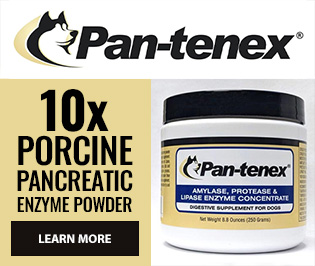Some dogs may develop mild mouth irritation or sores when starting a pancreatic enzyme supplement. While very uncommon, this reaction is most often due to improper preparation of the food or incorrect dosing. Fortunately, these issues can usually be resolved with a few simple adjustments to how the enzyme powder is used. You must also be sure that you are using the correct amount of enzyme based on your dog’s meal size.
Why Enzyme Powder Can Cause Mouth Discomfort
Pancreatic enzyme powders like Pan-tenex are highly concentrated digestive aids. They are designed to break down proteins, fats, and carbohydrates before your dog digests them naturally. If the powder is not properly mixed with food and given time to sit before feeding, some granules may remain active on the surface and irritate sensitive areas inside your dog’s mouth.
Steps to Prevent Mouth Sores from Enzyme Use
- Never use acetone-based enzymes: For more information, see our article “Acetone in Pancreatic Enzymes: Why You Should Avoid These Products for Dogs“
- Always mix the enzyme powder into moist food: The food should be slightly wet or moistened with (not hot) water to help the powder adhere and mix properly.
- Let it sit for 10–15 minutes (incubation): This rest period allows the enzymes to begin breaking down the food and reduces their activity on contact with your dog’s mouth. Some dogs do better with longer incubation times of 30 mins or more.
- Ensure proper dosing: Overdosing increases the concentration of enzymes in the food, which can raise the risk of irritation. Read our article How Much Enzyme Powder Should I Use Per Cup of Dog Food? for guidance, and refer to the Pan-tenex Feeding Guidelines.
- Do not feed dry kibble with enzyme powder: Dry surfaces prevent even mixing and leave active powder exposed.
For a visual guide, refer to our article How to Mix Enzyme Powder with Your Dog’s Food.
What to Do if Your Dog Already Has Mouth Irritation
If you notice signs of irritation such as redness, swelling, reluctance to eat, drooling, or visible sores near the mouth, take the following steps:
- Make sure you are not over-dosing the enzymes for your dog’s meal size.
- Contact your veterinarian to confirm the issue and rule out other causes.
- Once cleared, restart enzymes using the correct dose & preparation (incubation).
- Monitor closely for any signs of re-irritation.
Important Safety Reminders
Digestive enzyme powders are safe and effective when used properly, but they are powerful and must be handled with care. Always store the container in a dry area, out of reach of pets and children. Wash hands after handling the powder, and avoid inhaling particles.
Dosing can vary based on your dog’s meal size and the enzyme product being used. Always read the label, and as with any supplement, use only under the guidance of a veterinary professional.
Final Thoughts
Mouth irritation from enzyme powder can be unsettling, but it is preventable and usually easy to manage. With the right feeding routine, dogs can continue to benefit from enzyme support without discomfort. Explore more tips and feeding strategies in our Help Articles section or contact us if you have questions about your dog’s situation.

